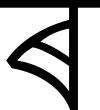Assamese is interesting because it is so very close to Bengali script. There are only two characters which are different.
Frequently, writing systems differ by a few characters because a writing system was adapted for spoken language B from a writing system designed for spoken language A, and B had a few sounds that were not represented in B’s writing system.
For one of the characters that is different between Bengali and Assamese, that appears to be the case. There is a Bengali glyph that represents both “wa” or “va” — which are not usefully different in spoken Bengali. In Assamese, the distinction is important, so they made a separate character.
For the other character, it’s slightly trickier. The Bengali “ra” character looks like the “wa”/”va” character, but with a dot just below and to the left of the “sail”, different from the character shown at the top of this post. The dot is a nukta, which is used in essentially all the Brahmi-derived languages to transliterate foreign sounds. It is similar to the way that we use italic script and the Japanese use Katakana script to say, “Yo! This is from a different language!”
Unlike italic and Katakana, the nukta operates on a phoneme basis instead of a word basis. As an analogy, it would be as if instead of writing “Johannes Bach”, I would write “Johannes Bak”, but with a dot under the “k”.
Thus, the Bengali “ra” by its look, says “This is a foreign sound. It is different, it is not natural, it is not part of who we are”. Using it would be a constant reminder that the people who wrote the script considered the readers to be “others”. My Bengali-speaking sources tell me that “ra” is a common sound in Bengali, and not at all “foreign” sounding.
Perhaps the Assamese were more sensitive to “foreign” influence; by making their own character without a nukta, they were perhaps claiming the sound as one of their own.
Note that there are three characters in both Bengali and Assamese that transliterate as “ra”, and in Bengali and Assamese both, the glyphs for the other two forms of “ra” both have nuktas.

